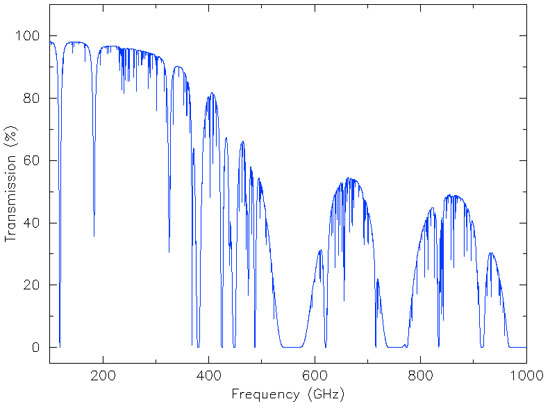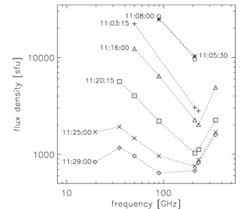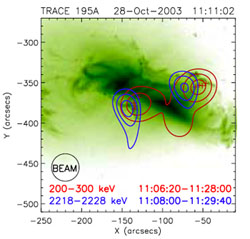Why submillimeter?
RHESSI detects and images emissions from relativistic particles
accelerated in solar flares, as described in many Nuggets in this
series.
The corresponding emissions at radio wavelengths, due to
gyrosynchrotron
emission (or possibly more exotic mechanisms) appear at the shortest
wavelengths.
These "submillimeter" wavelengths or THz (Terahertz) frequencies verge
on the far infrared, and the detectors may be either bolometers (as in
the IR) or heterodyne receivers (as in the radio bands).
Figure 1 below shows the atmospheric transmission at 100-1000 GHz
(3-0.3 mm) from an excellent site.

Figure 1:
Atmospheric transmission at an excellent mountaintop site, where the
"precipitable water vapor" is less than 0.5 mm equivalent thickness.
The weak submillimeter transmission bands are at about 0.67 and 0.87 THz.
At frequencies below 0.3 THz (wavelengths longer than one mm) the
atmospheric transmission improves drastically.
As any astronomer can tell from the plot in Figure 1, these are very
difficult wavelengths to observe at (just as RHESSI's observations of
MeV photons are also extremely difficult technically).
In astronomical parlance, the
extinction
is of order one magnitude per air mass!
Nevertheless two observatories have now successfully made solar flare
observations in the past solar maximum, and there have been simultaneous
RHESSI observations as well.
The two observatories are
COSMA in Switzerland, and
El Leoncito
in Argentina.
Gyrosynchrotron radiation
Generally high-energy electrons in a solar flare can be detected
either by thermal or nonthermal processes.
The thermal process is
free-free emission (the radio equivalent of X-ray
bremsstrahlung; note that at these long wavelengths,
free-bound emission
is unimportant).
The non-thermal process is
synchrotron
emission, and it is often thought of as "magneto-bremsstrahlung".
This name captures the idea that a fast electron gyrates around the
magnetic-field direction via the v x B force, and
this angular acceleration necessarily involves the emission of
electromagnetic waves, as originally predicted for astronomical
purposes by
Alfven
and Herlofson as early as 1950.
The synchrotron emission spectrum is complicated for electrons that are not
ultra-relativistic, which is not always the case for solar flares.
But if we make this approximation for 10 MeV electrons, we find the
characteristic emission frequency to be of order 100 THz for a
magnetic field of only 100 G.
So the THz frequency range (or even the true infrared)
is the natural part of the radio spectrum
to study high-energy electrons of the energies responsible for
RHESSI's high-energy continuum photons.
First observations
The flare of October 28, 2003, provided a first chance to compare
gamma-ray and submillimeter images and spectra, as shown in Figure 2.
Figure 2:
Left: radio spectra observed at Gornergrat, displaying the
"THz upturn" discovered in a different event observed at El Leoncito.
This unexpected feature was thus detected at both of the solar submillimeter
observatories.
Right: RHESSI
gamma-ray imaging of the same flare, as described in a.
previous Nugget.
The highest frequencies show a striking spectrum: unlike the expectation
of a decreasing intensity, normally ascribed in this context to a
non-thermal process (synchrotron emission), we see an increasing
intensity.
The red contours in the RHESSI image show the locations of high-energy
electrons possibly associated with this new radiation component.
Conclusion
This article introduced some of the ideas associated with submillimeter
observation of solar flares but did not delve into the novel interpretations
they help to reveal.
We will return to these interpretations - which feature exotica such as
pions, positrons, and proton beams - in a later Nugget.
Biographical note:
Hugh Hudson is a senior RHESSI researcher at SSL, with a checkered history
of submm observation as well.


